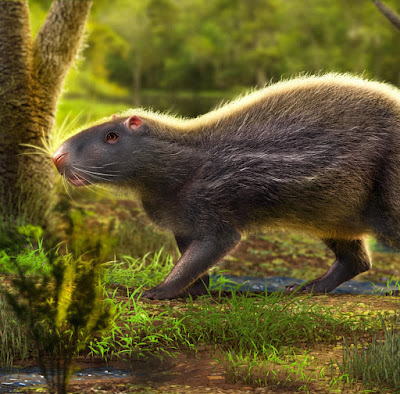|
|
| Пишет Species New to Science ( @ 2019-09-13 02:03:00 |
|
|
|
|
|
|
|
|
|
|
|
|
|
|
[PaleoMammalogy • 2018] Morphology of Cheek Teeth and Dental Replacement in the Extinct Rodent Neoepiblema Ameghino, 1889 (Caviomorpha, Chinchilloidea, Neoepiblemidae)
ABSTRACT
Neoepiblemidae (Caviomorpha) includes South American hystricognath rodents that together with Chinchillidae and Dinomyidae compose the clade Chinchilloidea. Despite the considerable advance in knowledge of the past decades, these extinct rodents are still poorly studied. To contribute to the taxonomy, systematics, and ontogeny of this group, in this paper we study the cheek tooth morphology of the genus Neoepiblema Ameghino, 1889, from upper Miocene deposits through qualitative and quantitative analyses. For this purpose, we describe the anatomical variation, perform a quantitative analysis using linear measurements, and provide comments on the dental replacement. Based on the cheek tooth morphology, our interpretations indicate that there are two species of Neoepiblema that can be differentiated from each other. Neoepiblema ambrosettianus is not a valid name, and N. horridula, the first described Neoepiblema species, is the senior synonym. Hence, N. acreensis is a valid name for the second species of the genus. In neoepiblemids, the premolar is replaced during the early postnatal period, similar to euhypsodont dinomyids and in contrast to some other euhypsodont caviomorphs (e.g., cavioids), which replace the premolar during the intrauterine stage. These data on dental replacement in neoepiblemids contribute to knowledge about the ontogeny of this extinct rodent group.
Leonardo Kerber, Francisco Ricardo Negri and Daniela Sanfelice. 2018. Morphology of Cheek Teeth and Dental Replacement in the Extinct Rodent Neoepiblema Ameghino, 1889 (Caviomorpha, Chinchilloidea, Neoepiblemidae). Journal of Vertebrate Paleontology. 38(6); e1549061. DOI: 10.1080/02724634.2018.1549061
 |
| Neoepiblema acreensis in Kerber, Negri & Sanfelice, 2018. Illustration: Márcio L. Castro |
ABSTRACT
Neoepiblemidae (Caviomorpha) includes South American hystricognath rodents that together with Chinchillidae and Dinomyidae compose the clade Chinchilloidea. Despite the considerable advance in knowledge of the past decades, these extinct rodents are still poorly studied. To contribute to the taxonomy, systematics, and ontogeny of this group, in this paper we study the cheek tooth morphology of the genus Neoepiblema Ameghino, 1889, from upper Miocene deposits through qualitative and quantitative analyses. For this purpose, we describe the anatomical variation, perform a quantitative analysis using linear measurements, and provide comments on the dental replacement. Based on the cheek tooth morphology, our interpretations indicate that there are two species of Neoepiblema that can be differentiated from each other. Neoepiblema ambrosettianus is not a valid name, and N. horridula, the first described Neoepiblema species, is the senior synonym. Hence, N. acreensis is a valid name for the second species of the genus. In neoepiblemids, the premolar is replaced during the early postnatal period, similar to euhypsodont dinomyids and in contrast to some other euhypsodont caviomorphs (e.g., cavioids), which replace the premolar during the intrauterine stage. These data on dental replacement in neoepiblemids contribute to knowledge about the ontogeny of this extinct rodent group.
 |
| Illustration: Márcio L. Castro |
Leonardo Kerber, Francisco Ricardo Negri and Daniela Sanfelice. 2018. Morphology of Cheek Teeth and Dental Replacement in the Extinct Rodent Neoepiblema Ameghino, 1889 (Caviomorpha, Chinchilloidea, Neoepiblemidae). Journal of Vertebrate Paleontology. 38(6); e1549061. DOI: 10.1080/02724634.2018.1549061
Pesquisadores estudam parente da capivara que viveu há cerca de 10 milhões de anos na Amazônia UFSM.br/2019/03/18/pesquisadores-estudam-par
